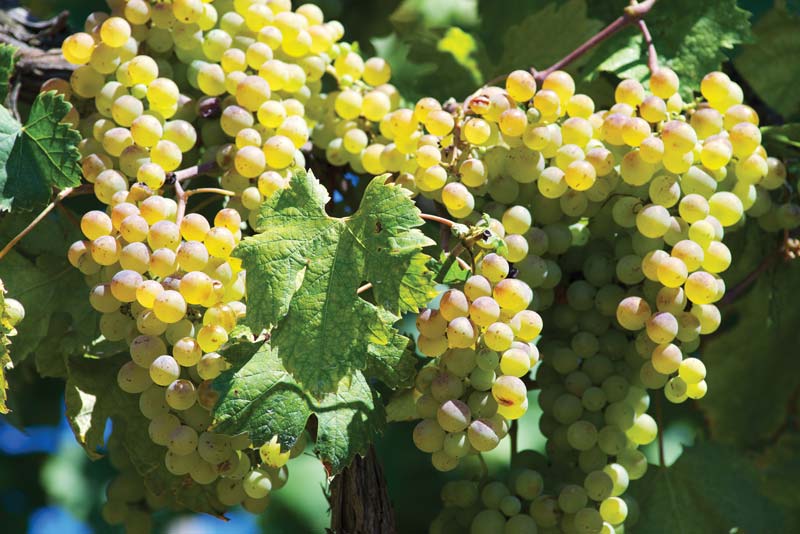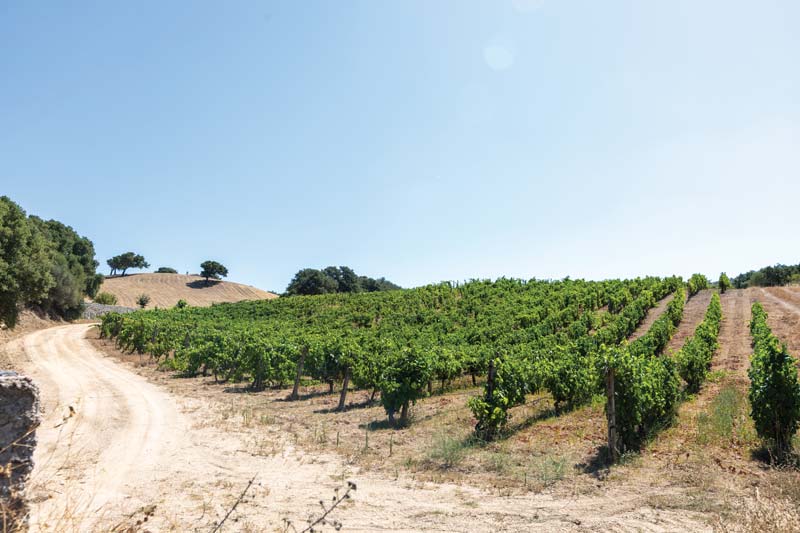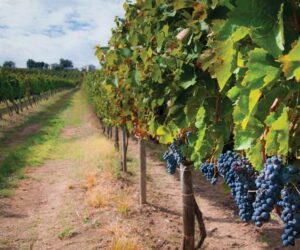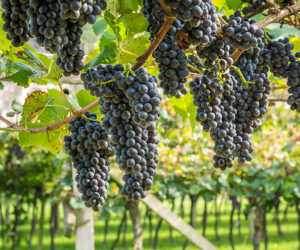A star of the Mediterranean

If you could put all the wonderful wines of Italy into one room, you would think you were in heaven! We do that almost every year at this early spring trade tasting, presented by Gambero Rosso. It features all Italian wines and is aptly named Tre Bicchierri, because the wines being presented are the top wines that earned the “three glass” distinction of quality. All the top producers from the various regions of Italy are there. It’s amazing to get so many of Italy’s best wines in one place. With all the indigenous and mainstream varieties, you have to stay focused on specific wines in a tasting this size.
The first year we visited this event we decided to focus on white wines from Italy. We found an abundance of one that really stood out that day . . . a grape called Vermentino, one that I did have experience working with but had limited success with. But its true capabilities were on display here at this tasting. The world of Vermentino awaited us with many excellent examples of the variability you experience between different producers and growing areas.
Vermentino’s Background
The earliest mention of Vermentino in literature is in 1658 in Piemonte, where vineyards were planted with grape varieties cortese (Cortese), nebioli dolci (Nebbiolo), and fermentino (Vermentino). Some scholars believe its name derives from the root, vermene, meaning young, thin, and flexible shoots. But the word origins going back to its first appearance in the literature, fermentino, meaning “ferment” referring to the fizzy character of young white wines, supports the former hypothesis. Vermentino has become the preferred name over the last 400 or so years with no real support as to why. Its morphological and DNA profile support that it is identical to Favorita in Piemonte and Pigato in Liguria. The Ligurian grape, Rollo, is sometimes confused with Vermentino, and both can be referred to as Rolle.
As with many grape varieties, historical records are handed down from generation-to-generation by word of mouth unless some written record exists. One hypothesis was it was introduced to Sardegna from Spain, but the variety is not found in Spain. Another places its origins in Greece or the Middle East, but no scientific evidence supports that thought either.
Vermentino is a white grape, very aromatic, and generally of very high quality.
Grown under the various synonyms, this supposed Italian grape is also widely planted in Southern France, notably in the Languedoc-Roussillon and Provence regions where its plantings have greatly increased in recent years. In Italian grape acreage reports Favorita and Pigato are listed separately and Italy still retains the most acreage of Vermentino in the world, although France is not far behind. Typical to French regional AOC rules it is blended with local grapes as well as Muscats, Roussanne, and Carignane Blanc (Mazuelo). It can also be a blending component in Provencal rosé wines. Outside of its home region, it can also be found in Lebanon, Australia, Texas, North Carolina, Idaho, Virginia, Oregon, and California.
In The Vineyard
Vermentino is a white grape, very aromatic, and generally of very high quality. Viticulturally it is early budding, hence somewhat susceptible to spring frosts. It is mid-ripening and does best when grown near the sea in its native range of Italy, Southern France, the island of Corse (Fr.), and Sardegna (It.).
Vermentino grapes are thin-skinned and light in color. It is a vigorous vine that is drought-resistant and thrives in hotter climates. I have tasted Vermentino from Italy, France, and California, but in reading reviews, and with an upcoming trip planned to Texas, I am curious as to see if I can find some examples of Hill Country Vermentino varietals. Most reviews talk about it being made with all stainless fermentation and aging, something dear to my heart with such an aromatic variety. Winemakers should want to express the grape and not something around it to mask the flavors. Bonuses in the winemaking process are preserving this grape’s natural acidity by preventing the malolactic fermentation (certainly regional and stylistic dependent) and enhancing mouthfeel.
The descriptors of the flavors of Vermentino range from fragrant, mineral, floral, fruity, citrus, spicy, and tropical. The latter come about when the grapes are grown in warmer regions. But care needs to be taken to pick before the fruit acidity starts decreasing too much. Sometimes an acidity adjustment is necessary in warmer years and almost the norm in California.
My experience with these white grapes in both home and commercial settings is fruit that is grown properly does not require any extended skin contact to generate optimum aromatics. So what does it mean to properly grow this grape? Some keys to coaxing the most from the clusters while hanging in the vineyard include incidental but not direct sun exposure, good air flow through the canopy, and harvesting when the flavors are there, not necessarily the sugar.
In The Winery
Focusing on the winemaking side of the grape, recall that the aroma compounds are found in the skin of white grapes and therefore some skin contact is needed. I like to refer to best practices with Vermentino as incidental skin contact — just enough contact while the must is being de-juiced (the term I use instead the word press). De-juicing is the process of a series of light pressure increases in the press until the juice flow starts to decrease. Then I release the pressure, mix the must, and repeat. While easiest to do with a pneumatic membrane press, the home winemaker using a typical basket press can utilize rice hulls evenly distributed in the must and then press normally until the juice flow starts to decline.
If you want to press firmer, switch to another receiving vessel and press harder for more yields. But make sure to treat these as two separate fractions. The firmer press may need some more attention because it will undoubtedly have a higher pH due to the hard press and longer skin contact.
I typically use one 4-cubic foot (0.11 m3) bag of rice hulls per ton (910 kg) of crushed and de-stemmed fruit (roughly 1 lb./0.45 kg rice hulls per 100 lbs./45 kg of grapes). Speaking from experience, I do not advocate for the use of enzymes as they can gum up your press process and overly complicate your day. Sure, you are going to find rice hulls in every nook and cranny of your press area, but that’s what brooms and wet/dry shop vacs are for!
Once you get your juice, allow it to cold settle overnight then rack off the grape solids (gross lees). The longer it settles the better the yield, but temperature and initial sulfur dioxide additions need to be considered. Depending on your growing region an acidity adjustment might be necessary. I am not afraid to adjust my acidity to around 6.5 g/L pre-fermentation with tartaric acid.

I use an aromatic yeast like QA 23 and ferment at a cool temperature of 54–59 °F (12–15 °C). After alcoholic fermentation is complete, I chill and add sulfur dioxide to prevent spontaneous malolactic fermentation (MLF). Certainly, if your acid is too high you could consider an MLF, but that is a stylistic choice. Keep the wine cool through the winter, stirring the lees to help with mouthfeel and bottle as the cellar warms in the spring. Voila! You have Vermentino!
At the annual Tre Bicchierri tasting, we experience many wonderful examples of what the grape variety can be all about. The Vermentino wines of Sardinia and Liguria are the benchmarks to match when you can get your hands on the grape to make in your own cellar. I long to make another Vermentino like a vintage I made in 2016. It was not a large volume that we made, but it was delicious and we can only be inspired every year when we return to this tasting and seek out the current year’s winners.
Vermentino recipe
Yield 5 gallons (19 L)
Ingredients
- 100 lbs. (45 kg) Vermentino fruit
- 5 lbs. (2.3 kg) rice hulls
- Distilled water
- 10% potassium metabisulfite (KMBS) solution (Weigh 10 g of KMBS, dissolve into about 75 mL of distilled water. When completely dissolved, make up to 100 mL total with distilled water.)
- 5 g Lalvin QA23 yeast (CY3079 can be used as a substitute)
- 5 g Diammonium phosphate (DAP)
- 5 g Fermaid K (or equivalent yeast nutrient)
Equipment
- Food-grade Brute bucket, about 45-gallons (170-L)
- 5-gallon (19-L) carboy
- 6-gallon (23-L) carboy
- 6-gallon (23-L) plastic bucket
- Racking hoses
- Inert gas (nitrogen, argon, or carbon dioxide)
- Refrigerator (~45 °F/7 °C) to cold settle the juice (remove the shelves so that the bucket will fit)
- Ability to maintain a fermentation temperature of 55 °F (13 °C). TIP: Use a 33-gallon (125-L) plastic can as a water bath. Place ice blocks in the water to maintain a relatively constant temperature.
- Thermometer capable of measuring between 40–110 °F (4–45 °C) in one degree increments
- Pipettes with the ability to add in increments of 1 mL
- Tartaric acid (addition rate is based on acid testing results)
Step by step
- Crush and press the grapes. Mix in your rice hulls so that they are evenly dispersed with the must. Move the must directly to the press and press lightly until the juice flow diminishes. Increase the pressure of the press, taste the juice and transfer the hardest pressed juice to a separate vessel.
- Transfer the juice(s) to a 6-gallon (23-L) bucket, keeping your fractions separate, if this is what you choose to do. During the transfer, add 3 mL of 10% KMBS solution per gallon of juice (0.8 mL/L). This addition is the equivalent of 50 mg/L (ppm) SO2. Move the juice to the refrigerator.
- Let the juice settle at least overnight. Layer the headspace with inert gas and keep covered.
- Measure the Brix and acidity.
- Adjust the titratable acidity to 6-7 g/L. If the acidity is greater than 7 g/L, consider the option of inoculating for the malolactic fermentation at the completion of the alcoholic fermentation described below.
- When sufficiently settled, rack the juice off of the solids into the 6-gallon (23-L) carboy.
- Prepare yeast. Heat about 50 mL distilled water to 108 °F (42 °C). Measure the temperature. Pitch the yeast when the water is 104 °F (40 °C). Sprinkle the yeast on the surface and gently mix so that no clumps exist. Let sit for 15 minutes undisturbed. Measure the temperature of the yeast suspension. Measure the temperature of the juice. You do not want to add the yeast to your cool juice if the temperature of the yeast and the must temperature difference exceeds 15 °F (8 °C). To avoid temperature shock, acclimate your yeast by taking about 10 mL of the juice and adding it to the yeast suspension. Wait 15 minutes and measure the temperature again. Do this until you are within the specified temperature range. Do not let the yeast sit in the original water suspension for longer than 20 minutes. When the yeast is ready, add it to the fermenter.
- Add Fermaid K or an equivalent yeast nutrient.
- Initiate the fermentation at room temperature ~65–68 °F (18–20 °C) and once fermentation is noticed, (~24 hours) move to a location where the temperature can be maintained at 55 °F (13 °C).
- Two days after fermentation starts, dissolve the DAP in as little distilled water required to completely go into solution (usually 20 mL). Add directly to the carboy.
- Leave alone until bubbles in the airlock are about one bubble per minute. Usually about two to three weeks. Measure the Brix every 2–3 days. If acidity is high, consider inoculating with a lactic acid bacteria culture.
- The wine is considered dry when you taste it and it does not taste sweet anymore. Add 3 mL of fresh KMBS (10%) solution per gallon of wine (0.8 mL/L). Transfer the wine to the 5-gallon (19-L) carboy and lower the temperature to 38–40 °F (3–4 °C). If there are any sulfide-like (rotten egg) odors, rack the wine off the lees. If the wine smells good, then let the lees settle for about two weeks and stir them up (bâtonnage). Repeat this every two weeks for eight weeks. This will be a total of four stirs.
- After the second stir, check the SO2 and adjust to 30–35 ppm free.
- After eight weeks, let the lees settle. At this point, the wine is going to be crystal clear or a little cloudy. If the wine is crystal clear, then that is great! If the wine is cloudy, then presumably, (if you have kept up with the SO2 additions and adjustments, temperature control, kept a sanitary environment, and there are no visible signs of a re-fermentation) this is most likely a protein haze and you have two options: Do nothing – it’s just aesthetics — or clarify with bentonite.
- While aging, test for SO2 and keep maintained at 30–35 ppm.
- Once the wine is cleared, it is time to move it to the bottle. This would be about six months after the onset of fermentation. Keep in mind this wine has had the malolactic fermentation inhibited (unless you opted to for an acid correction). If all has gone well to this point, given the quantity made, it can probably be bottled without filtration. Your losses during filtration could be significant. That said, maintain sanitary conditions while bottling, and you should have a fine example of a clean Vermentino.
Sulfur dioxide additions: The recipe calls for specific additions of sulfur dioxide at specified intervals. Once these scripted additions are made, you must monitor and maintain to 30–35 ppm. Adjusting as necessary using the potassium metabisulfite solution previously described or by methods of your own choosing. Testing can be done at a qualified laboratory, or in your home cellar using various commercially available kits.







